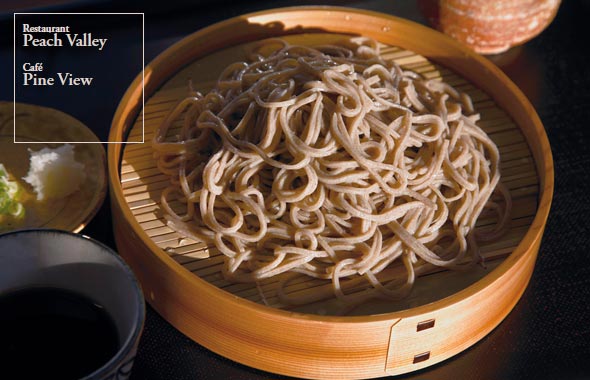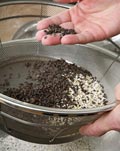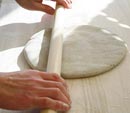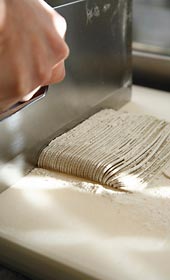





Further separating the buckwheat hulls


Soba — Buckwheat Noodles There are many self-professed “soba experts,” who fuss about where to eat soba or about the fragrance and consistency of handmade noodles. On top of that, if you go to a noodle shop that someone tells you about, you’ll find a multitude of choices from hard to soft, smooth noodles that it will seem like everyone has their own preference and no one agrees when it comes to soba. But at MIHO MUSEUM’s Peach Valley Restaurant, you will find the most amazing handmade soba. The flour is laboriously ground by hand using a millstone, so the restaurant only offers ten servings per day. So what are we waiting for? Let’s start with some shiny, freshly boiled noodles with visible grains. Try them, they are unbelievably smooth! When bitten into, they seem soft at first yet they are perfectly al dente. First comes the flavor of the kombu, bonito, and mejika (bullet tuna) broth. Then comes the ultimate taste sensation of the grated daikon, which is piquant yet sweet. Heap it on to your heart’s content and fold it into this amazing soba and broth. The sharp flavor of the daikon comes from the natural soil in which it was produced. Its deep taste also helps reset your palate. Now let’s see how the noodles are made. Our buckwheat seeds come from Morioka, where the producers fortunately remove any stone debris and send us the grains prepared just right. Then these grains are placed into the millstone and finely ground. When the brown hulls break, they are separated further by hand in the first step of the miling process. Because electric mills rotate much faster than hand mills, they produce heat that dissipates the fragrance and flavor of the buckwheat. Our restaurant staff slowly grinds the buckwheat grains with a heavy millstone. They do this carefully three times so as not to throw away any hulls that may still have seeds in them. Next, the buckwheat is put through a sieve twice to remove most of the hull. In the sixth step, we finally get the first round of flour, a yellowish powder laced with moisture that covers the millstone. From this extremely finely textured flour is taken the flour used for kneading the soba. The flour is ground and sieved a seventh and eighth time, when a different part of it begins to get crushed as gradually it grows mysteriously darker. A soft, moist grass-like fragrance of the soba drifts by. Finally, after the ninth round of milling, we have our soba flour, which is mixed with 20% Canadian flour and water. While adjusting its consistency and texture, the dough is stretched, kneaded, and cut into the noodles we know and love. That was a long process, but they only take a minute and half to boil! Then they are rinsed thoroughly with cold water and garnished with scallions, grated daikon, and broth, and served on the table. In an encyclopedic manual on handmade soba, it is written, “It is very difficult to ensure soba flour that has good color, fragrance, and taste… If the dough of the soba flour does not spring back when kneading it by hand, then it’s useless for a soba shop to be in business… If aspiring to make the soba by hand, first you must be fastidious about the flour.” What more can we say about our hand-ground, handmade soba from Morioka? Soba connoisseurs, taste test it to your heart’s content! |
The first round of hand-milled
flour is finally produced |
 |
|
 |
|
 |
|
 |
|
 |
|
 |